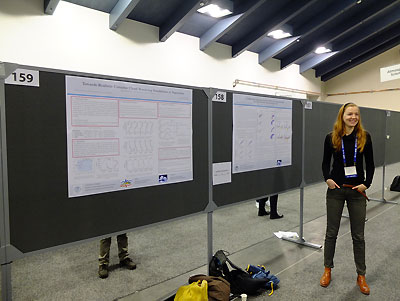|
|
|
| Fig. 1: Thirza van Laar , Poster at AGU 2015 Copyright: Thirza van Laar |
AGU (American Geophysical Union) Fall Meeting 2015
14-18 Dec. 2015, San Francisco, United States
The AGU (American Geophyscial Union) Conference is a yearly meeting, held in San Francisco. This year there were approximately 24,000 participants, with this number it is the largest meeting on Earth and Space science in the world. With in total more than 1700 sessions there were a lot of interesting things to hear and to see.
In one of those sessions I presented a poster myself. The session was titled 'Large-Eddy and High-Resolution Simulations for Improved Understanding and Parameterization of Clouds and Boundary Layer Processes'. The focus of the session was on small (subgrid) scale processes (e.g. convection) in the atmosphere and how to represent them.
One of the goals of my PhD research is to simulate cumulus clouds on a small scale (high resolution) in a realistic set-up, this fitted nicely in the session.
The model I will use in my project is the recently developed ICON. As a first check on the model results I compared the output from ICON (two different runs) with LES results and observations taken at JOYCE, for a clear sky day during the HOPE campaign. In general can be said that the main characteristics of the boundary layer were well resolved by ICON. The vertical profiles of potential temperature, specific humidity and horizontal wind speed of ICON all show a good resemblance with measurements from the radiosonde. Next to that also the sensible and latent heat fluxes show good results when comparing to observations. What ICON does not capture correctly is the variance of the vertical wind speed. Since the LES model has a much finer grid and does resolve the turbulent processes, the main conclusion of my poster presentation was that we have to increase the resolution of our ICON simulation in order to be able to resolve the processes important for cumulus cloud formation.
During the poster session there was a lot of interest from the audience and I got to talk to many people about my work, which made it a really useful experience. During the rest of the week there were a lot of interesting talks and posters as well, giving me the chance of getting insight in and learning about many different subjects. All in all attending the AGU was really worthwhile and beneficial for me as young researcher!
PhD Student: Thirza van Laar- PhD student at University of Cologne
PhD project: The Impact of Regional-Scale Surface Heterogeneity on Boundary-Layer Cloud Fields
Poster title: Towards realistic cumulus cloud resolving simulations at supersites
Link to abstract: https://agu.confex.com/agu/fm15/meetingapp.cgi/Paper/60766











